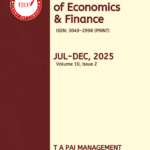The importance of the Union Budget has been diminishing in the recent years, with economists and investors worldwide viewing it as just a macro-economic policy statement, rather than a practical allocation of a country’s resources. However, at times like this when the economy is in shambles, the budget automatically gets greater importance. With the long-awaited budget 2020 coming up, expectations from the government are sky high. This budget is supposed to combat the current slowdown and introduce initiatives to strengthen the economy for the years to come and prove to the world that the slowdown won’t hamper the country from achieving its goal of being a five trillion economy.
Looking at the expectations for international trade, i.e. exports and imports in the upcoming budget, we need to first look at the current scenario of exports and imports. Escalating trade tensions between countries, along with the global economy slowdown has led to a decrease in exports of not just India, but many other countries across the globe. India’s exports dropped by 1.8% in December 2019. India is mainly dependent on domestic demand, especially recently. With the slowdown hitting the domestic demand hard, and the manufacturing sector, in particular, taking massive hits in growth, it is time for the country to increase exports as a percentage of GDP and depend on international trade for growth a little more. India exports form part of just a hint above 10% of its GDP. For a comparison, China and Japan’s exports form part of 19% of their GDP.
The FICCI pre-budget report advocated that at least 20 percent of India’s GDP needed to come from exports in order to reach the target of a 5 trillion economy. However, with the current level of performance, it may only be a pipe dream. However, there is a silver lining in this situation. Amidst the different trade wars, the decreased efficiency of China’s exports which was a result of the Hong Kong protests and rising price levels, global importers may be looking at India to fulfill their demand. However, it is up to India to grasp that opportunity.
The government has announced various measures in the previous year, including additional export incentives, financing and credit for exporters to boost exports. However, it is time to make a bigger splash with the upcoming budget. One of the main instruments to promote exports is the duty drawback scheme which offers a rebate on duties and tax on materials used in manufacturing goods to be exported. It is done to ensure that exporters can offer competitive prices in global markets. However, the main drawback of this scheme is that it has a cap which disincentivizes exporters using high-quality material.
The other scheme which helps exporters is the EPCG (Export Promotion Capital Goods), which seems to be running out of steam, given the latest numbers. The EPCG allows duty-free import of capital goods, given that the person exports a certain quantity of goods in a specified time period. The revenue foregone to the EPCG has dropped by almost 70% which basically means that manufacturers are spending less and less on procuring capital goods to manufacture high-quality export products. This duty structure should be rationalized in order to increase exports. Although the WTO doesn’t usually approve of high-government intervention through subsidies to exporters, there are some ways for the government to increase exports through spending. There have to massive upgrades in government spending in the following areas allocated in the budget to have hope of increasing exports.
- Access to credit: Small exporters who form a huge chunk of total exports absolutely need to have access to credit. Making the access easy is a huge step in boosting exports. The importance of fintech comes up in this area too.
- Skill development: Although India has an advantage over other countries in the number of people available, it has largely been unskilled labor. Developing the skills of labor can massively increase production, and hence, exports. The government can allocate a portion of the budget for skill development under its existing schemes.
- Technology upgrades: This is perhaps the most important thing to do in the current world. Indian exporters need to be able to compete in the markets, which are now digitally driven. Access to cutting-edge technology is costly and this is where the budget comes in. Access to funds can smoothen the process of technology acquisition. The budget is expected to increase funding to increase technology infusion and help exports go up.
- Infrastructure improvement for manufacturers: This is a no-brainer. Allocation of funds toward improvement of infrastructure directly increases the number of products available for export.
- Intellectual property: The IPR policy (Intellectual Property Rights) shows the path to bring all intellectual property rights under one umbrella. The geographical indication tag which is used on goods having a geographical origin and having attributes or qualities that can be traced to that particular geography, is an important section of IPR. GI tagged goods have been given the status of intellectual property and they assume greater value than generic goods. Allocating funds towards this in the budget will help exporters greatly.
While all these can help boost exports, there is also an obstacle looming in the distance. The Federation of Export Organizations (FIEO) has stated that further escalations in the US-Iran tensions may have a severe negative impact on India’s exports to Iran. And since Iran is a major importer of Indian goods to the tune of almost rupees 24,956 crore in the previous year, this would severely impact the balance of payments of the country. Advocating the need for research and development in India, the Engineering Exports Promotion Council of India said that the budget should do away with any duties on imports made for R&D, since it is a backbone for any industry and would help compete with international players.
Looking at the imports side of the picture, things aren’t much better. The high domestic demand leaks out to impact the imports in our country since domestic production has dipped in the previous year due to the manufacturing sector’s slowdown. The imports of our country have increased, especially in the ‘Others’ category. According to Commerce and Industry minister Piyush Goyal, one out of four products being imported form part of that category. To provide a little more context and clarity, Mr. Goyal stated that the government would start a process of refining the HSN codes and bring more clarity to the category of ‘Others’.
The government is likely to increase the import duties on said items and impose restrictions on certain goods in that category. The budget will most likely contain a large increase in import duties to curb the excessive imports on more than 50 items, targeting about $56 billion worth of imports. The hike in import duties would help the local manufacturers by providing a level playing field. According to the IMF, the hike would be on items relating to chemicals, jewelry, handicrafts and electronic goods, among others. However, this move might impact smartphone manufacturers who import accessories for their products. It would also significantly impact the plans of companies like IKEA, who had previously stated that the existing custom duty structure was a challenge. The trade ministry has also asked the government to consider imposing a Border Adjustment Tax which would be levied on top of all existing duties to help level the playing field in the local market. The dire shape of the Indian economy is something which every person in the entire world has been noticing. The Union Budget is a fantastic opportunity for the government to show the world that India is on top of things and is doing everything she can to quash the situation. Budget is not a kill switch which can change our economic fortunes, but it is certainly a stand made by the government to show the intention of the government to turn the tides.














Leave a comment